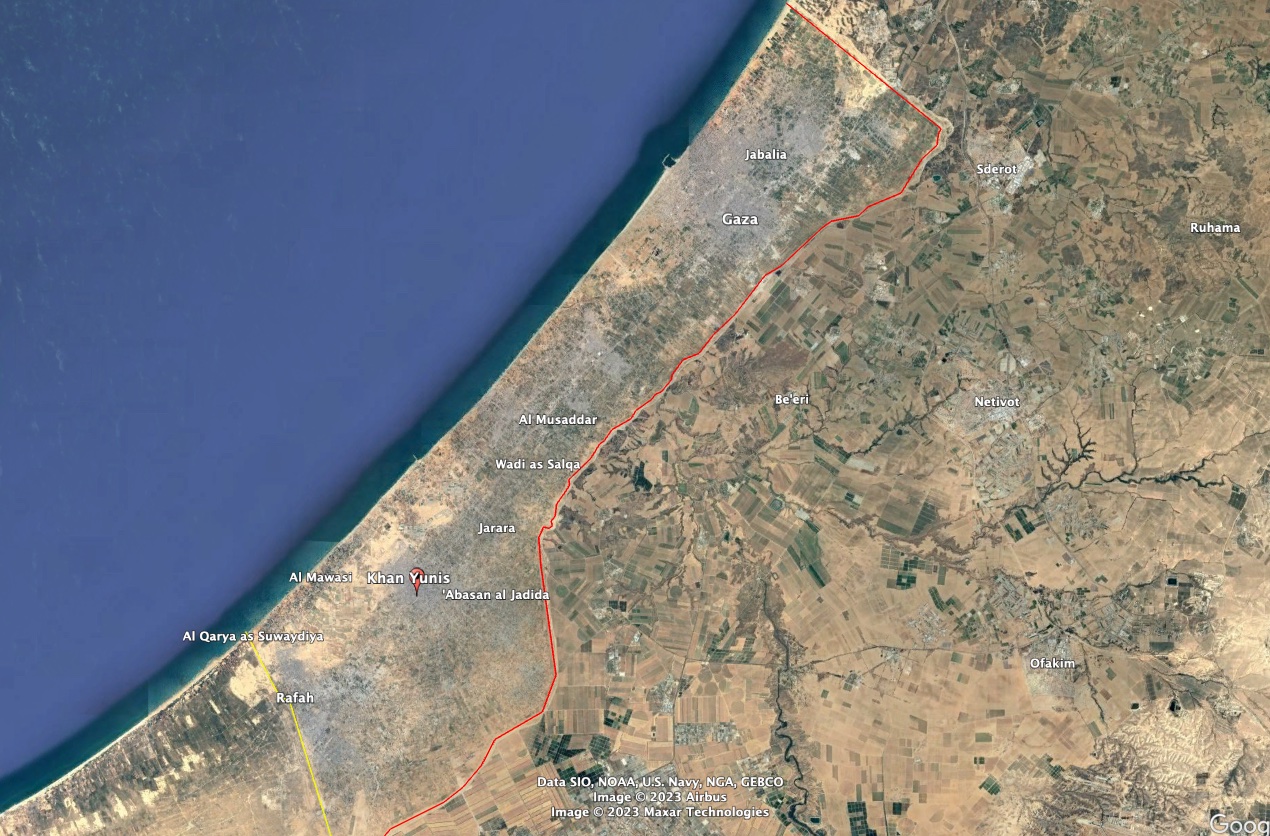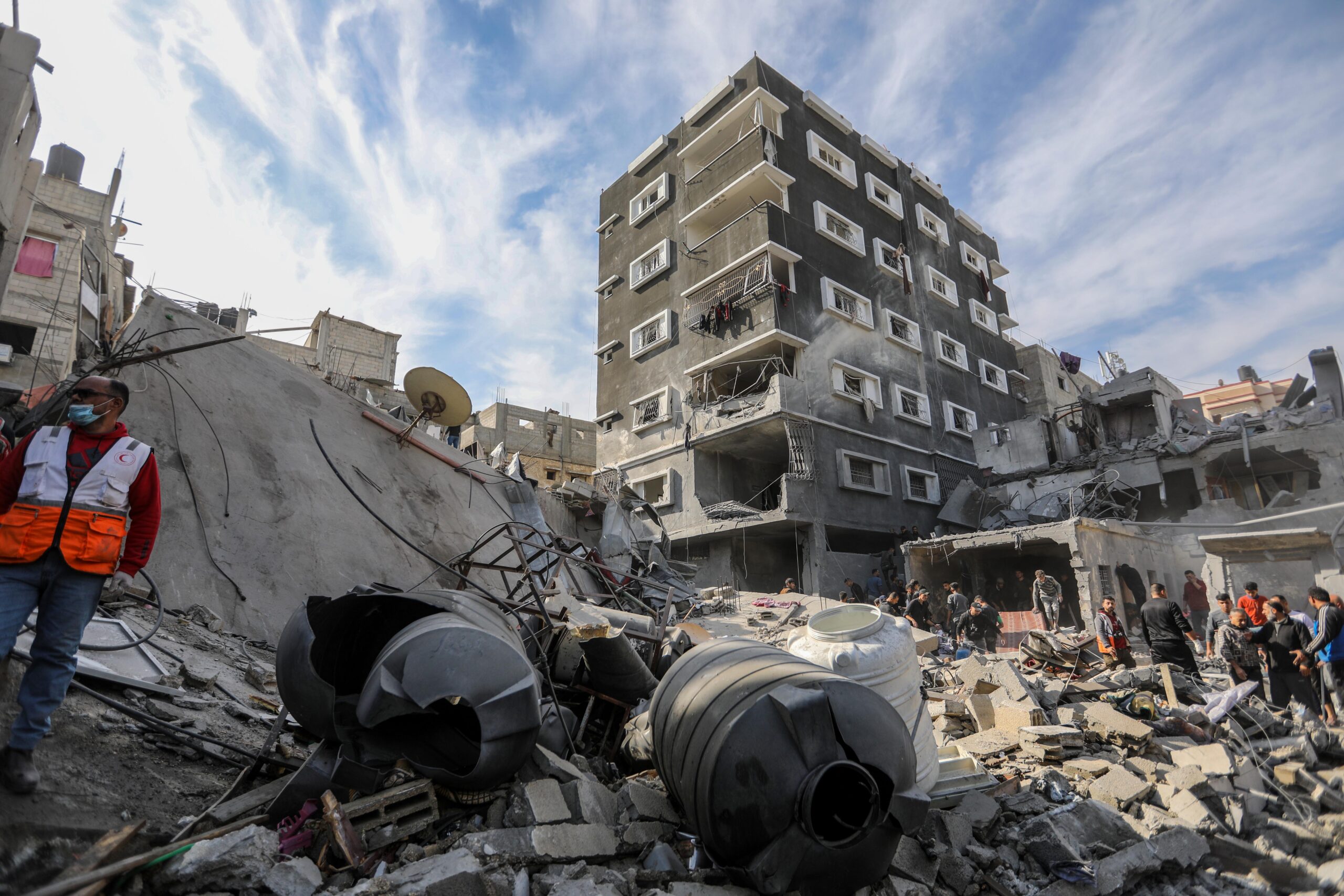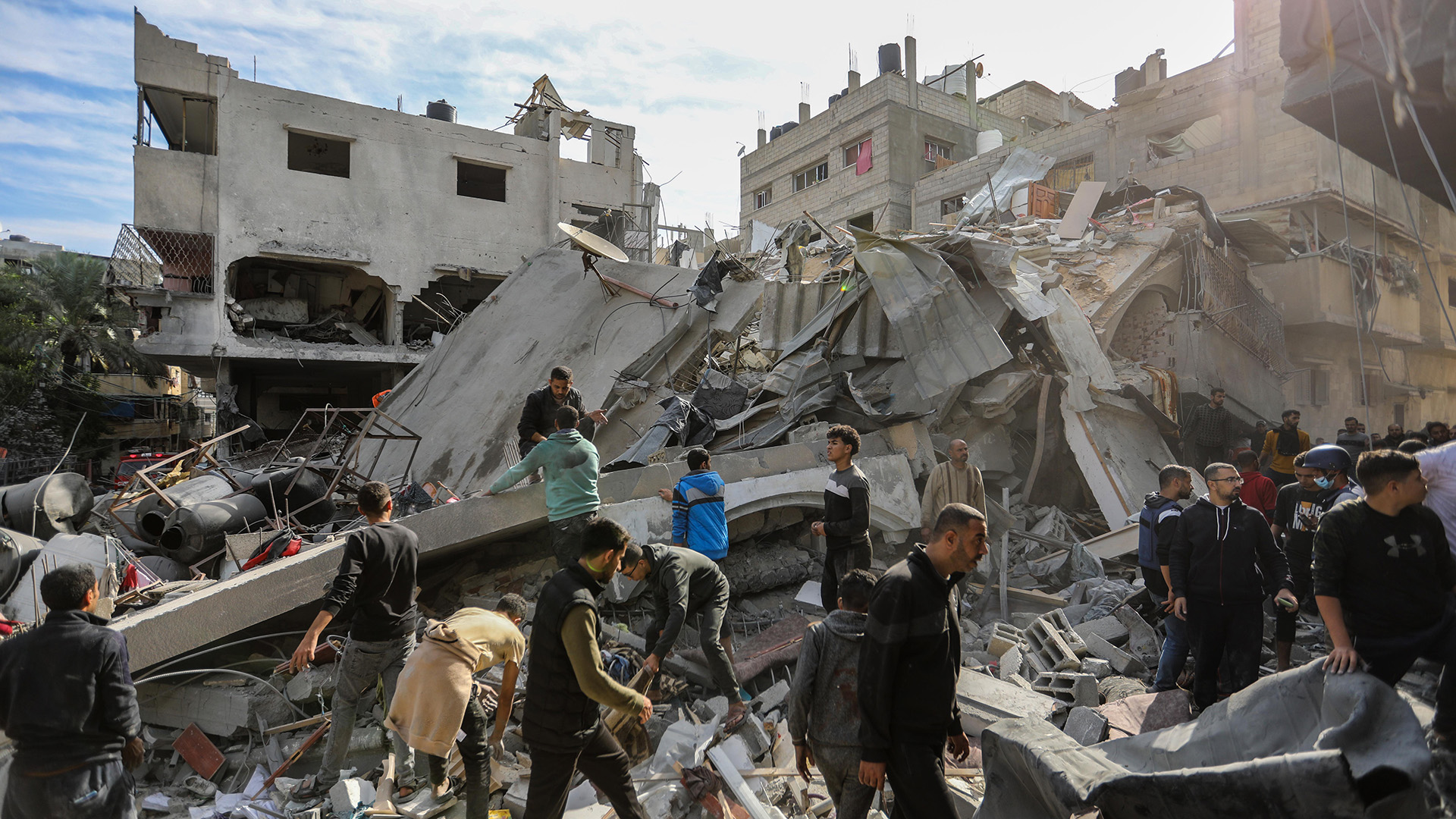Under increasing international pressure to agree to a ceasefire, the Israeli Defense Forces (IDF) have stepped up its combat operations, especially in southern Gaza. The IDF said on Friday it launched more than 450 attacks across the enclave, with a particular emphasis on Khan Yunis, the largest city in southern Gaza. That’s where the IDF says Hamas leaders are located and hostages still being held.
“The IDF is conducting a powerful, and focused operation, moving from tunnel to tunnel, from house to house, step by step” in Khan Yunis,” it said on Telegram Friday.
With so many Palestinians forced to move out of northern Gaza, however, the city is even more densely populated than normal and constant airstrikes there, as well as elsewhere across Gaza, have killed thousands of Palestinians since a seven-day ceasefire ended Dec. 1, The Wall Street Journal reported, citing Hamas authorities in Gaza. The War Zone cannot verify casualty claims by either side.

As the fighting rages on, the U.S. on Friday vetoed a United Nations Security Council demand for an immediate humanitarian ceasefire. Thirteen members voted in favor of a brief draft resolution, put forward by the United Arab Emirates, while Britain abstained.
That demand came in the form of an “Article 99” measure invoked Wednesday by United Nations Secretary-General Antonio Guterres.
The article “enables the Secretary-General to bring to the attention of the Security Council any matter which may threaten the maintenance of international peace and security,” according to the UN.
“We are facing a severe risk of collapse of the humanitarian system,” Guterres wrote in his letter invoking the article. “The situation is fast deteriorating into a catastrophe with potentially irreversible implications for Palestinians as a whole and for peace and security in the region. Such an outcome must be avoided at all cost.”

This is the first time Guterres has exercised Article 99 since he became Secretary-General in 2017, according to the UN. The last time it was invoked was during fighting in 1971 that led to the creation of Bangladesh and its separation from Pakistan.
Given the likelihood that the U.S. would provide cover in the UN, but also knowing that American officials have called for restraint and a limited timeline, Israel pressed forward, fighting across Gaza.
The IDF said it targeted anti-aircraft positions, found weapons and intelligence and in one case, “including “rocket and mortar launchers, RPGs, explosives, and intelligence materials” in a school.
“The troops continue to operate to locate and destroy underground tunnel shafts, weapons, and additional terror infrastructure,” the IDF said.
In Khan Yunis, ground troops instructed the Israeli Air Force to carry out “precision strikes” during a two-hour engagement that “killed numerous terrorists,” the IDF said.
In addition, in an overnight activity against Hamas naval and intelligence capabilities, Israeli Navy forces “used precise ammunition to strike dozens of terror infrastructure sites used by the Hamas naval forces in the central and southern Gaza Strip,” the IDF said. “The terror targets that were struck included military sites and posts where Hamas terrorists were operating, observation posts, and storage compounds containing weapons. IDF Naval forces continue to cooperate with ground troops to strike terror infrastructure.”
Ahead of this uptick in fighting, the Israeli Air Force dropped leaflets over Khan Yunis, with an ominous warning from Quranic verse playing on the name Hamas gave to its invasion: Al-Aqsa Flood.
“The flood carried away the wrongdoers,” said the flyer.
There was still heavy fighting in Gaza City as well, where the IDF said it encountered Hamas operating at a school complex in the heart of the Shejaiya neighborhood.
The IDF said it found a large cache of weapons during a raid on Al-Azhar University in Gaza’s Rimal district.
“Within the university campus, IDF troops located terror infrastructure, including an underground tunnel that ran from the university’s yard and continues to a school one kilometer away,” the IDF said on Telegram. In addition, the IDF said it found “explosive devices, rocket parts, launchers, explosive device detonation systems, and several technological assets were located and taken for an intelligence analysis and investigation.”
“The findings show that Hamas exploited the university’s building for attacks against our forces,” the IDF said.
In a separate raid on what it claims was “a Hamas observation control room in the area of the Shati Hospital,” the IDF said it found “200 communication devices and dozens of cameras” as well as “an operational tunnel shaft, magazines, grenades, a sniper post, military equipment and firing holes.”
That follows a day when the IDF said it hit about 450 targets from the air, sea and ground Thursday during fierce battles with Hamas. That’s the highest number of reported strikes since the end of a truce with Hamas last week.
The IDF released footage obtained from the bodycam of a Hamas operative during fighting in northern Gaza’s Jabaliya neighborhood, showing armed members of the terror group crawling on the ground inside a building.
The IDF says the Nahal Brigade encountered the operatives, who had fired anti-tank missiles at the troops. The cell was struck by a drone, The Times of Israel reported.
Another member of the cell was killed by the troops, and on his body, the camera was found, the IDF says.
Hamas said it carried out several attacks against Israeli troops in Khan Yunis and Gaza City.
“During the last 24 hours, the Al-Qassam Mujahideen were able to completely or partially destroy 21 military vehicles in all fighting axes in the Gaza Strip,” Abu Ubaida, spokesman for the Al-Qassam Brigades, claimed on Telegram. “They also targeted the Zionist forces and vehicles penetrating the concentration and positioning areas with anti-fortified shells and anti-personnel devices. They clashed with them from zero distance and caused certain deaths and injuries.”
Hamas released a video titled “Tel Aviv is burning… and Jerusalem will be liberated” displaying how it hides its L-M90 rocket launchers and rockets under a canvas before loading and firing. We have no way of knowing when or where this video was taken.
Despite intense pressure from Israeli forces in Gaza, it continues to launch rocket attacks, including on Tel Aviv.
Video emerged on social media of a jet landing at nearby Ben Gurion airport during the barrage.
Images and video emerged on social media of a large group of Palestinian men stripped to their underwear, blindfolded and made to kneel sparked complaints of abuse.
“The Israeli Nazi occupation army committed an uncovered crime yesterday by apprehending a group of displaced Palestinian civilians who were disgracefully stripped of their clothing within a school in the Gaza Strip,” Hamas said on Telegram. “The kidnapping, invasive searches, and disrobing, documented in a criminally explicit manner, once more reveal behaviors typical of mercenaries and terrorist militias lacking any principles and disregard for laws, a characterization fitting for this Israeli Nazi army. We hold the occupation forces responsible for the lives and well-being of these civilians.”
An Arab news network said its reporter was among the men detained by the IDF.
The New Arab’s Arabic language service, Al-Araby Al-Jadeed, said its correspondent Diaa al-Kahlout was arrested along with his brothers, relatives and other civilians in Beit Lahia.
IDF spokesperson Jonathan Conricus told CNN the men pictured were “Hamas members and suspect Hamas members.” He said they were “without clothes in order to make sure they’re not carrying explosives.”
Hamas claims that “a number of our Zionist captives were killed and injured in a barbaric bombing carried out by the Zionist occupation on several areas of Gaza City.”
They did not offer additional details, but also said an Israeli soldier it held hostage since its Oct. 7 invasion was killed during a failed rescue attempt.
“A special Zionist force was discovered while trying to advance to liberate an enemy prisoner and clashed with it, which led to the death and injury of members of the force,” Hamas claimed on Telegram.
The Israeli Air Force responded with airstrikes to cover the operation and as the IDF withdrew, a firefight led to the death of the captive, Hamas claimed. They identified the hostage as Sa’ar Baruch, who was 25. Hamas also said it recovered an IDF special forces soldier’s rifle and communications device in the battle. The War Zone cannot independently verify the claim, however, lists of the hostages published by Israel identify one of them as Sahar Baruch. He was a civilian student who was 24 when he was seized from his home, according to Reuters.
The IDF did not specifically address Baruch, but said that “overnight, two IDF soldiers were severely injured during an operation to rescue hostages held by Hamas in the Gaza Strip. During the operation, numerous terrorists who took part in the abducting and holding of hostages were killed. No hostages were rescued in this activity.” The War Zone could not independently verify that claim either.
Of some 240 people taken hostage that day, 137 remain in Gaza captivity after others were recovered during a truce. Some have been declared dead in absentia by Israeli authorities.
The parents of one of the remaining hostages claims they were reprimanded by the The Red Cross.
Families of Israelis being held hostage by Hamas were reprimanded by representatives of the Red Cross in a meeting earlier this week, with the Red Cross telling one family they need to “think about the Palestinian side,” KAN TV reported on Thursday night.
The Biden administration has asked Congress to approve the sale of 45,000 shells for Israel’s Merkava tanks for use in it war against Hamas, Reuters reported, citing a U.S. official and a former U.S. official.
The request is being made as concerns grow about the use of U.S. weapons in a war that has killed civilians in the Palestinian enclave since Israel responded to an attack on Oct. 7 by Hamas militants.
The intense bombardment and heavy ground fighting is exacerbating a tremendous humanitarian crisis in Gaza.
In addition to those killed many have been injured and there has been severe damage to homes and other buildings as well during the bombardment.
After an Israeli airstrike, family members looked for their loved ones.
Amid the horrors of war, these children found small respite playing among the ruins of a mosque bombed by the IDF.
A spokesman for the UN’s Palestinian relief efforts painted a grim picture of the humanitarian crisis in Gaza.
“Civil order is breaking down in #Gaza – the streets feel wild, particularly after dark – some aid convoys are being looted and UN vehicles stoned. Society is on the brink of full-blown collapse. @UNRWA continues to serve the population with what limted aid we have.”
At least one Palestinian woman complained about the Hamas response, saying they take the food while civilians suffer.
Meanwhile, there were reportedly clashes between civilians and Hamas over humanitarian aid trucks that did make it into Khan Yunis.
On Wednesday, Maxar Technologies released satellite imagery it said spotlighted “a number of schools, hospitals and other locations where displaced Palestinians have been sheltering over the past week. Additionally, two new field hospitals have been recently established in Khan Yunis and Rafah.”
The fighting continued along the Lebanese border as well.
“Throughout the day, IDF aircraft struck a number of Hezbollah terror targets, including terrorist infrastructure,” the IDF said on Telegram. “Furthermore, in the last hour, a number of launches were identified from Lebanon toward Israeli territory.”
Three Lebanese soldiers were lightly injured today by Israeli shelling in southern Lebanon, medical sources told AFP, while the Lebanese army reports no casualties in a second attack on a hospital.
On Tuesday, two people, including a Lebanese soldier, were killed in Israeli cross-border shelling, according to the Times of Israel. It was the first among Lebanese army personnel to be killed since the start of almost daily exchanges of fire on the border between Israel and Iran-backed Hezbollah.
The IDF acknowledged the incident and expressed “regret,” saying it was targeting a Hezbollah position and not the army.
Biden administration officials at multiple government agencies have in recent days expressed concerns that Israel may be seeking American military aid for fighting in Lebanon, two U.S. officials told HuffPost.
The officials were briefed on the Lebanon concerns before a Tuesday afternoon meeting of top policymakers from across the national security establishment, one official said. HuffPost said it interviewed multiple U.S. and foreign officials who were not authorized to speak on the record.
“This last week, the level of concern in D.C. about a potential war on the Israel-Lebanon front has gone up three or four notches,” said Randa Slim, a senior fellow at the Middle East Institute think tank.
A senior advisor to President Joe Biden said the U.S. believes Iran and its Islamic Revolutionary Guards Corps (IRGC) are involved in the planning and execution of drone and missile attacks by Yemen’s Houthi group on Israel and ships in the Red Sea.
The comments by deputy White House national security adviser Jon Finer are among the most explicit to date by a U.S. official alleging Iranian involvement in the Houthi attacks, Reuters reported.
Finer spoke hours after the United States imposed new sanctions aimed at throttling what U.S. officials say is Iranian financial support for the Houthi strikes.
The Houthis “would not have the weaponry, would not have the intelligence, would not have the motivation to do this, were it not for the role of the IRGC,” Finer told an Aspen Security Forum conference in Washington.
The Houthis have repeatedly attacked shipping in the Red Sea and launched missiles and drones at Israel. There have been several instances where U.S. Navy vessels have had to shoot down Houthi drones and missiles. You can read more about that in our story here.
Though the U.S. says Iran is behind the Houthi attacks, there are differences with Israel on how to respond, The Wall Street Journal reported. Israel and the U.S. have shot down most of these airborne threats, but the U.S. has told Israel to let the American military respond to the Houthis, instead of risking an Israeli response that could expand the conflict, U.S. and other government officials told the publication.
On Nov. 19, the Houthis staged a helicopter-borne raid on the Galaxy Leader, a Bahamian-flagged vehicle carrier transiting the Red Sea. The Houthis have turned the vessel into a tourist attraction.
The IDF, responding on Friday to a Reuters investigation that determined its forces killed a Reuters journalist in southern Lebanon on Oct. 13, said the incident took place in an active combat zone and was under review.
Without directly addressing the death of visuals journalist Issam Abdallah, a military statement said Lebanese Hezbollah fighters had on that day attacked across the border and Israeli forces opened fire to prevent a suspected armed infiltration.
A Reuters special report, published Thursday, found that “an Israeli tank crew killed a Reuters journalist and wounded six reporters in Lebanon on Oct. 13 by firing two shells in quick succession from Israel while the journalists were filming cross-border shelling.”
The two strikes killed Reuters visuals journalist Abdallah, 37, “and severely wounded Agence France-Presse (AFP) photographer Christina Assi, 28, just over a kilometer from the Israeli border near the Lebanese village of Alma al-Chaab.”
“Reuters spoke to more than 30 government and security officials, military experts, forensic investigators, lawyers, medics and witnesses to piece together a detailed account of the incident. The news agency reviewed hours of video footage from eight media outlets in the area at the time and hundreds of photos from before and after the attack, including high-resolution satellite images.”
“As part of its investigation, Reuters also gathered and obtained evidence from the scene including shrapnel on the ground and embedded in a Reuters car, three flak jackets, a camera, tripod and a large piece of metal.
As the Israel-Gaza war continues, on December 8, the Committee To Protect Journalist’s research showed that at least 63 journalists and media workers were among the more than 18,000 people killed since the conflict began on October 7—with more than 17,000 deaths in the Palestinian territories of Gaza and the West Bank and about 1,200 in Israel. This deadly toll on journalists’ lives is coupled with harassment, detentions, and other reporting obstructions as they go about their work across the region.
On Thursday, Israeli Prime Minister Benjamin Netanyahu issued a stark warning to Hezbollah leader Hassan Nasrallah, saying that Israel would turn Beirut into Khan Yunis if he chooses war.
Four pro-Hezbollah fighters were killed on Friday in an Israeli drone strike on their car in the south of Syria, according to the Syrian Observatory for Human Rights (SOHR).
The attack targeted a “taxi” near Al-moror roundabout in Al-Ba’ath city in Al-Qunaitrah province, where the four bodies were charred inside the targeted car, according to SOHR.
No U.S. troops have been injured in nine attacks on U.S. bases in Syria and Iraq over the past 24 hours with a mixture of drones and rockets, Fox News reported. The number of such attacks since Oct. 17 is now 84.
A loose-knit group of Iranian-backed militias called the Islamic Resistance in Iraq claimed credit for al least two of those attacks on Friday, one at the Koniko oil facility in Syria and the other at Al-Asad Air Base.
That follows one near the U.S. Embassy compound in Baghdad.
We reached out to the Pentagon and U.S. Central Command for details and will update this story with any they provide.
The is a developing story. We will update it when there is more news to report about the Israel-Hamas war.
Contact the author: howard@thewarzone.com
